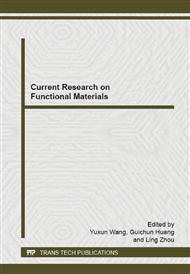p.3
p.8
p.15
p.21
p.30
p.37
p.41
p.50
Surface Properties of TiNi Alloy Treated by Micro-Arc Oxidation under Different Voltages
Abstract:
The effects of micro-arc oxidation (MAO) voltage (370V, 400V, 420V) on the surface morphology, adhesion of film/substrate, corrosion resistance and fretting friction and wear properties after micro-arc oxidation and heat-treatment for 48h of TiNi alloy were investigated. The results show that, as the voltage gradually increases: (1) micro-arc oxidation coatings form, when the voltage increase to 420V, the coating shows a significant micro-arc oxidized porous characteristics; (2) the Ca/P ratio in the coatings also increases, so the Ca/P ratio can be controlled by adjusting the voltage of micro-arc oxidation; (3) the corrosion resistance of MAO coatings can be significantly improved by increasing the output voltage, the corrosion rate and the corrosion potential of 420V are smaller two magnitude than 370V’s; (4) the coating of 420V shows lower friction coefficient with higher resistance, narrower wear scar width; (5) the MAO coatings have formed different types of hydroxyapatite crystals (HA) after immersed in high temperature and pressure reactor for 48h, and the phase composition of the coating are mainly apatite.
Info:
Periodical:
Pages:
21-29
Citation:
Online since:
October 2014
Authors:
Price:
Сopyright:
© 2014 Trans Tech Publications Ltd. All Rights Reserved
Share:
Citation:


